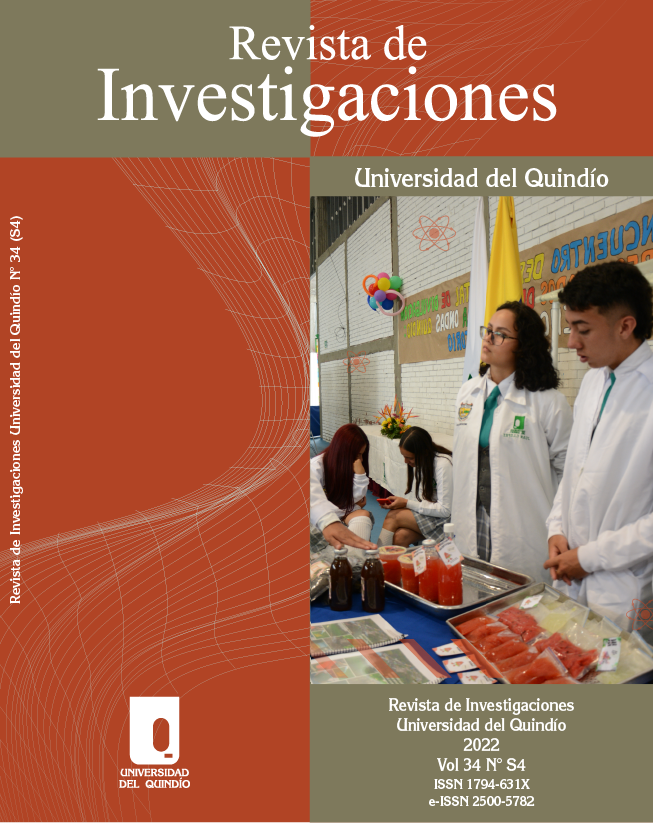Caracterización del almidón de plátano pompo rayado (Mussa Manini)
DOI:
https://doi.org/10.33975/riuq.vol34nS4.1066Palabras clave:
plátano, musácea, almidón, amilosa, propiedades funcionalesResumen
En este trabajo se realizó la caracterización del almidón de plátano pompo rayado extraído a través del método húmedo. El material obtenido se caracterizó de acuerdo con sus propiedades fisicoquímicas como contenido de humedad, fibra cruda y relación amilosa/amilopectina y adicionalmente se estudiaron sus propiedades funcionales: índice de Blancura (IB), índice de absorción de agua (IAA), índice de solubilidad en agua (ISA) y el poder de hinchamiento (PH). Los resultados indican que porcentaje de amilosa fue aproximadamente del 30,2 %, porcentaje dentro de encontrado para musáceas, pues, el contenido de amilosa depende del origen botánico. Por su parte, presenta un contenido de fibra alto encontrándose en 6,68%, superior a lo encontrado para otras variedades de plátano, las cuales se encuentran entre 2.5 – 4,0%. El estudio de las propiedades funcionales del material obtenido evidencia un índice de blancura mayor en comparación con las otras musáceas. Los valores para IAA que son aceptados por la FAO oscilan entre 0,82 y 15,52. Sin embargo, para los ISA se encontraron índices bajos cercanos a 0.333. El PH es un parámetro que va de la mano con el IAA en consecuencia, presenta el mismo comportamiento, con lo cual se pudo establecer que el almidón a tratar se encontró dentro de los rangos considerándose de buena calidad.
Descargas
Citas
Kaur, L., Dhull, S. B., Kumar, P., & Singh, A. (2020). Banana starch: Properties, description, and modified variations - A review. International Journal of Biological Macromolecules, 165, 2096-2102. https://doi.org/https://doi.org/10.1016/j.ijbiomac.2020.10.058
Marta, H., Cahyana, Y., Djali, M., & Pramafisi, G. (2022). The Properties, Modification, and Application of Banana Starch. Polymers, 14(15).
Moreno, J. L., Tran, T., Cantero-Tubilla, B., López-López, K., Becerra Lopez Lavalle, L. A., & Dufour, D. (2021). Physicochemical and physiological changes during the ripening of Banana (Musaceae) fruit grown in Colombia [https://doi.org/10.1111/ijfs.14851]. International Journal of Food Science & Technology, 56(3), 1171-1183. https://doi.org/https://doi.org/10.1111/ijfs.14851
Pinzon, M. I., Sanchez, L. T., Garcia, O. R., Gutierrez, R., Luna, J. C., & Villa, C. C. (2020). Increasing shelf life of strawberries (Fragaria ssp) by using a banana starch-chitosan-Aloe vera gel composite edible coating. International Journal of Food Science & Technology, 55(1), 92-98. https://doi.org/https://doi.org/10.1111/ijfs.14254
Sanchez, L. T., Pinzon, M. I., & Villa, C. C. (2022). Development of active edible films made from banana starch and curcumin-loaded nanoemulsions. Food Chemistry, 371, 131121. https://doi.org/https://doi.org/10.1016/j.foodchem.2021.131121
Villa Zabala, C. C. (2020). An Overview on Starch Structure and Chemical Nature. In C. C. Villa Zabala (Ed.), Starch-based Nanomaterials (pp. 3-9). Springer International Publishing. https://doi.org/10.1007/978-3-030-42542-5_2
Publicado
Cómo citar
Número
Sección
Licencia
Derechos de autor 2022 Revista de Investigaciones Universidad del Quindío

Esta obra está bajo una licencia internacional Creative Commons Atribución-NoComercial-SinDerivadas 4.0.


